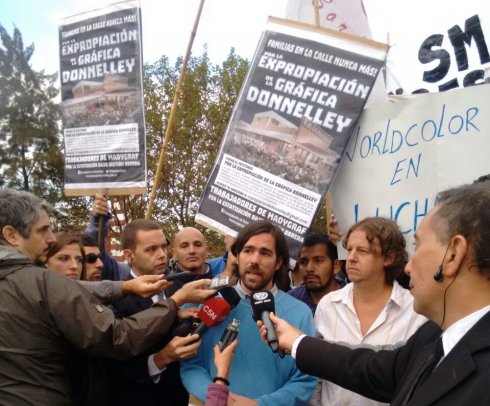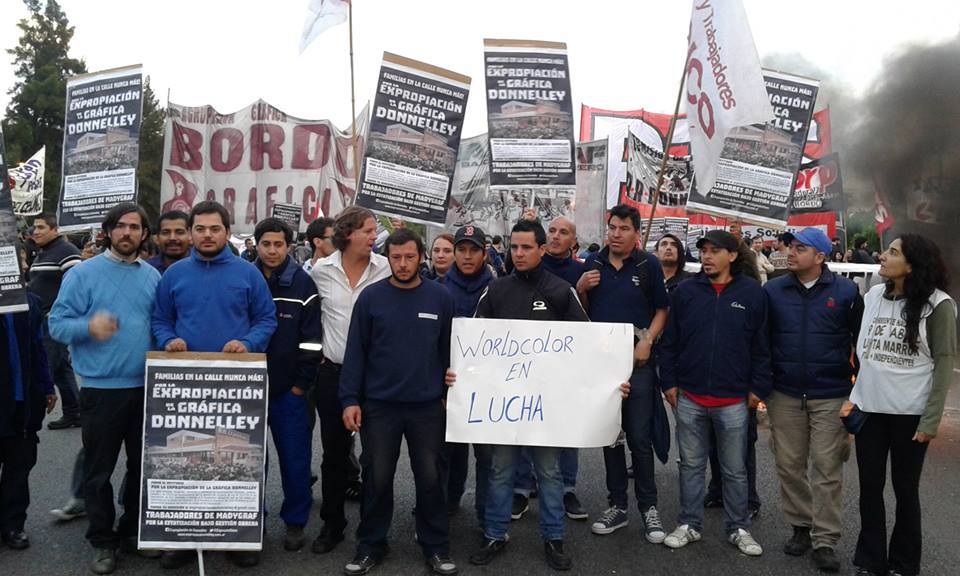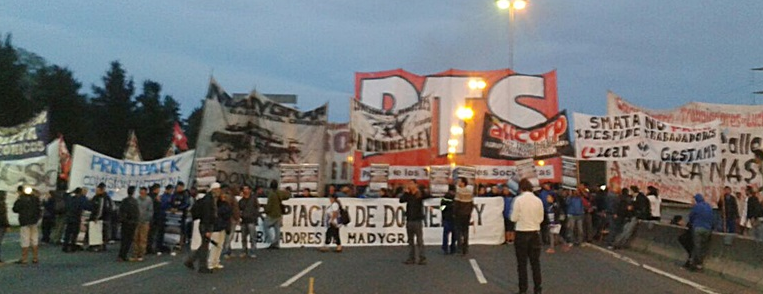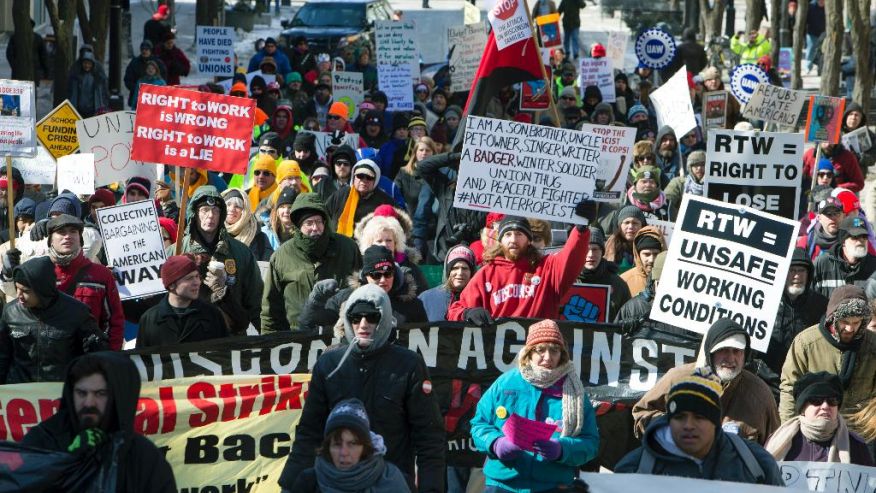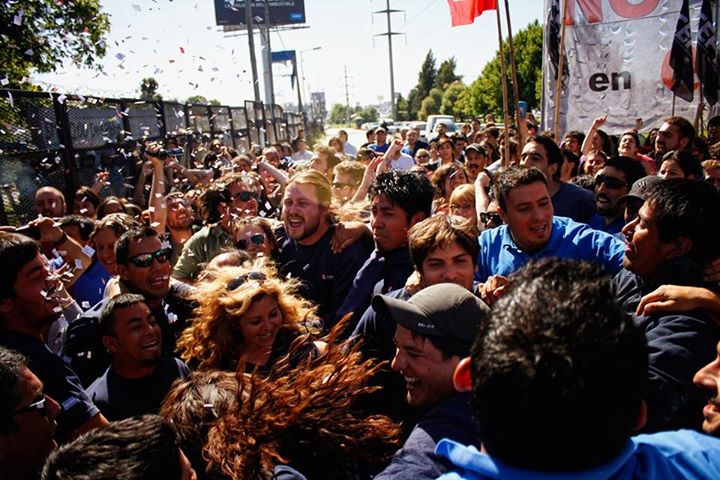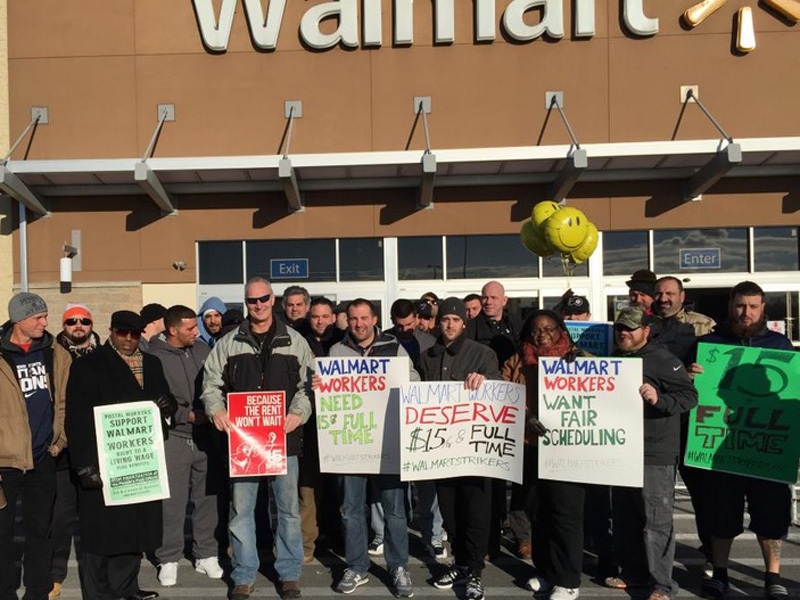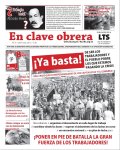US
Workers and the Crisis
06/06/2008
Claves No 3 Thursday, May 29, 2008
Hurricane Katrina, which destroyed New Orleans in 2006, revealed a society where millions of poor people are marginalized, among whom African-Americans and Latinos are a disproportionate majority. Now, more and more people state that the US is headed toward a recession, and the biggest financial crisis of recent decades, together with growing inflation, is already hitting workers and people in the US. (1)
A snapshot of the crisis
In 2007, foreclosures increased by 57% (after increasing 42% in 2006). This percentage means thousands of newly homeless people, who are moving in with relatives or friends, or, in the worst cases, living in their cars. The first months of the crisis created a new landscape in cities that were, until very recently, highly-valued, like San Francisco: empty houses, abandoned by their owners who can no longer pay the installments or have been evicted. The US Senate recently approved a $300 billion assistance plan in new mortgage loans. (2)
Faced with this economic catastrophe, with no end in sight, the Republican and Democratic political establishment is responding to the interests of big businesses and big banks, as shown by the injection of more than $780 billion (3) from the Federal Reserve, to create liquidity in the market, a measure that is no less than an enormous life preserver for those who amassed millions of dollars in profits in recent decades.
Meanwhile, it is estimated that 28 million people are going to need food stamps, the most significant increase since the 1960s. Astronomical mortgages, unemployment and the rise in food prices are forcing many workers, in spite of having a job, to depend on government assistance.
In this setting, in spite of the fact that many governments, including several in Latin America, are sowing expectations that a future Democratic administration will manage the crisis in a more “progressive” way, both parties are getting ready to unload the crisis on workers and the people.
Scars from neo-liberalism
The solution that the bourgeoisie found for the crisis that began after the end of the postwar boom, culminated in an enormous setback for the working class on an international scale. The bosses’ offensive led by Ronald Reagan and Margaret Thatcher had a big epicenter in the US. Although the bureaucracy of the AFL-CIO union federation carried out several actions at the beginning of the 1970s, under pressure from rank and file workers, as the crisis deepened, collaboration between the leadership of the unions and businesses increased. The turning point was reached with the defeat of the 1981 air traffic controllers’ strike, which was used by Reagan as a point of support for launching his attack on what workers had won. From that moment on, there were more and more big defeats that weakened the strength of the working class, by fragmenting and splitting its ranks. Now, after more than two decades of neo-liberalism, under Democratic and Republican administrations, union membership is at its lowest level, near 10%. And although Bush’s two terms have meant a worsening of bad conditions, massive layoffs and a looting of workers’ wages, Democrat Bill Clinton’s two terms were not far behind in cutting public spending, creating terribly inadequate jobs and destroying social programs.
A working class divided and fragmented
Recent decades have meant big fragmentation in the ranks of workers: between first-class workers and second-class workers with uncertain, temporary or part-time jobs. Moreover, there are big ethnic and racial divisions exploited by the bosses and the bureaucracy that encourage strong racial prejudices, mainly among white workers, as well as tensions between African-Americans and Latinos. Added to this, women and young people continue to be sectors of the US proletariat that get passed over.
The US working class is a powerful social force of more than 140,000,000 (4) people. However, fragmentation and weakening of its organizations have diluted its political weight, reducing it to participation in the elections inside of the two-party system (where only a sector of the workers participates). Although the Democratic Party was its historic political representation, since the 1980s, a big part has turned to the Republican Party.
Industrial centers like Detroit, the headquarters for automobile factories, are now impoverished cities, since a big number of businesses moved overseas in search of cheap labor and to the “free states” inside the US. In those states, the bosses have more “opportunities” to boycott or prohibit unions, as one of main US employers, the Wal-Mart supermarket chain, the icon of destroying what workers have won, has done.
The “Wal-Mart model” (5) is pushing wages down, as has happened in the auto industry, where the low wages of the Dana auto parts’ company shortened the “yardstick” that “the Big Three,” General Motors, Ford and Chrysler, shared. When the UAW negotiated wage reduction and the double pay scale (new workers start with lower wages and no medical insurance), the Big Three demanded the same. This, together with structural deterioration of the auto industry (6), is causing devastation in the most concentrated sectors of the working class.
It is on this setback for the working class (and the exploitation of the semi-colonies) that imperialist democracy is built. The productivity that the economy of the world’s most powerful country brags about, is supported precisely by increased exploitation: more hours at work for lower wages. A US worker with a full-time job worked 46.2 weeks in 2004, 10.2 weeks more than a Swedish worker, and while in Europe there is a minimum time for annual vacations (4 weeks) for a worker on the books, in the US, it depends on the will of the companies. Nor is there anything in the US like maternity leave for women workers, to give but one example of the gains destroyed during the neo-liberal decades. (7)
As we indicated above, although this offensive was undertaken by both parties, it is a reality that Bush’s two terms have meant a consolidation of the legal and economic anti-worker structure, increasing the number of the poor and benefiting the rich with tax cuts.
The difference between first-class and second-class workers is combined with the ethnic and racial divisions that we mentioned, for example, an African-American worker earns 70% of the wages of a white worker for performing the same job. To this gap is also added the difference with Latino workers (more difficult to measure because their jobs have been made enormously uncertain and because of undocumented workers). However, this gap can be observed in the degrees of poverty among workers. Although they are a minority in the total population and in the workforce, poor Latinos (21.9%) and impoverished African-Americans (24.7%) are than double the percentage for whites (10.8%). (8)
Richer businessmen and poorer workers
In the context of this offensive by the bosses, the concentration of wealth has enjoyed sustained growth: what was lost by workers not only will not be recovered, but the gap between rich and poor is constantly growing larger.
Since 1979, the income of the richest 5% has grown by approximately 42%, while that of poorest 80% only increased by 10% (9) (see the graph).
In the land of opportunities, it is increasingly obvious that these opportunities are for few people: between 1992 and 2005 an average CEO saw his pay stub increase by 186.2%, while an average worker only had a wage raise of 7.2%, that is, in 2005 an executive earned 262 more than a worker. (10)
The negative aspect of this phenomenon was the impoverishment of broad layers of the working class. Although the US economy has increased its productivity by 67% since 1979, a worker’s average wages grew by 8.9% (and 7.7% of that increase occurred only between 1995 and 2000) (11). Increases in income during recent years correspond to an increase in hours worked, and not to higher wages, and growth of consumption was owing in large part to the enormous indebtedness of working-class families, which are now facing their debts with devalued housing and greater unemployment.
The Latinos
The incorporation of Latinos into the workforce has been significant, with almost 20 million immigrant workers (mainly Latinos), around 15% of the workforce. In spite of the fact that Latinos have the worst jobs and lowest wages (together with women and African-Americans), they are a big part of tendencies towards recovery of union organization in workplaces.
The fact that one of the biggest unions is SEIU-HERE (services, cleaning, gastronomy, and restaurants) with 2 million members, two-thirds of whom are Latino immigrants, speaks about this phenomenon. This process was already in evidence some years ago, when Latinos participated in defensive struggles in spite of the difficulties in getting organized, and in antiwar demonstrations, adding the support of their community, especially of youths, the children of immigrants (born in the US), a sector very active against anti-immigrant laws in 2006.
As part of the working class, Latinos show a tendency which, though small, is encouraging for all workers. Even amidst a hostile climate for Latinos in general and the undocumented in particular, they are a big part of the new sectors organized in new unions, in previously existing unions, or in struggle alongside their communities. In addition to their economic weight, their union membership is also substantial: around 2 million, more than 10% of the organized working class, in spite of raids, arrests and deportations. In spite of the historically xenophobic policy of the unions, 1 out of every 10 unionized workers is an immigrant. Without ignoring the problem of the low rate of unionization, the growing participation of Latinos in unions is encouraging, since it represents a large portion of the young sectors of the working class, that are not burdened by decades of betrayals and defeats, and that can revitalize the unions’ struggle with their action.
The strike at Smithfield Foods, the pork processing plant (one of the biggest in the world with 5,500 workers, a majority of whom are African-Americans or Latinos) in 2007, for recognition of their union the UFCW and against racist intimidation directed at the workers, was a small example of this tendency. The workers fought side by side, defending their undocumented comrades, and went beyond the halfhearted actions of the union to defend their organization from being sabotaged by the bosses. They aimed at a victory for all the workers of the plant.
However, it must be pointed out that while racist prejudices persist in a large part of the working class, the bourgeoisie and especially the Republican Party and conservative sectors have mounted a big political initiative within the Latino community. The impressive display of government and the Republicans during the recent visit of Pope Ratzinger, organizing a ceremony with more than 60,000 people, of whom the overwhelming majority were Latino, in New York, was an indication of this. We need only remember that the Catholic Church, though still in a minority, already played a big role in the varied immigrants’ movement in 2006, by encouraging divisions and deflecting the process into the dead end of Congressional debates.
Not only did a big sector of resident Latinos vote for the Republicans in the last presidential elections (more than in the year 2000), but the Republican Party also won a big base for Bush’s proposed “guest worker” program.
The thing is that the most reasonable sectors of the imperialist bourgeoisie see in Latinos, even in the undocumented, an enormous source of cheap labor, without rights of any kind. This explains the rejection of harsh anti-immigrant laws and the strange “support” by the US Chamber of Commerce for legalization of the undocumented (certainly a legalization “made to order”). Participation by sectors of the union bureaucracy in the immigrants’ movement takes place for the same reason, since Latinos form a significant social force in important sectors of the economy. Even when the bureaucracy has been one of the biggest groups inciting US chauvinism and encouraging the silence of an accomplice about the mistreatments and persecutions, it found itself forced to support, in some way, the demand for the minimal democratic right of legalization.
Faced with this reality, a workers’ response is urgent. Otherwise, aberrant phenomena like African-Americans supporting anti-immigrant policies will recur; the divisions will continue to grow, and the longest-established sectors will win the contest for this big group, legalizing modern slavery and in this way weakening the struggle of all workers. Contrary to racist prejudices, white workers have their best allies in the immigrants and the most exploited sectors, for strengthening the entire working class and preparing its struggle to confront the effects of a crisis that has already begun to afflict the poorest people, and for getting organized in spite of big difficulties.
The AFL-CIO bureaucracy
The AFL-CIO rose in 1955 from the union of the traditional AFL (American Federation of Labor) and the CIO (Congress of Industrial Organizations), created in 1932 with a more militant profile at its beginnings.
In August, 2005, the first big split took place, with the withdrawal of the Teamsters Union (IBT), the Hotel Employess and Restaurant Employees Union (HERE), the United Food and Commercial Workers International Union (UFCW), and the Service Employees International Union (SEIU), that formed the “Change to Win” coalition
The division took place over the war in Iraq, and especially over the policy of organizing new sectors, promoted by "Change to Win," which demands that more weight be given to the new sectors to gain neogitating power. However, the new coalition has not represented any alternative, as shown by its position on the anti-immigrant laws (that affect a big sector of these unions), nor has it set out a workers’ independent politics. Like the AFL-CIO, “Change to Win” supports the Democratic Party in the elections, with some for Obama and others for Clinton. At the end of the 1970s, only 22% of workers were affiliated with a union, after having reached the historic maximum of 36% in 1953.
The industrial working class, so renowned in the Democratic Party primaries, has seen how the union bureaucracy surrendered each and every one of its conquests. The conciliatory politics of the bureaucracy have weakened the unions as organizations for struggle, and their leaders have become direct representatives of the bosses.
The most recent example was the open betrayal of the UAW in September 2007. For the first time since 1976, 73,000 workers of 82 General Motors plants in the US carried out the first national strike against the company. Two days later, the leaders ended the strike, saying that it was necessary to make some concessions because “if the company wins, we all win." The union reached an agreement with Ford and Chrysler in the same way, thus offering "the Big Three" automakers what they were demanding: reduction of wages and of medical coverage, suspensions and voluntary retirements "to compete better." Just a few days later, the union surrendered the lengthy struggle by the autoparts workers at American Axle (a subsidiary of GM), that paralyzed the factory since February (affecting national and international production) against a 50% reduction in wages. Amidst this enormous crsis, when jobs have been cut for four consecutive months, the bureaucracy is threatening workers who want to struggle with the specter of factory relocations and layoffs, accusing them of putting their comrades’ source of employment at risk.
– The US before the crisis (Data from 2006)
304,000,000 total population
51.7 million were living in poverty
35 million went hungry (inlcuding 13 million boys and girls)
45 million were with medical insurance (The US has no public health service)
– The US work force (Source: National Jobs for All Coalition and the US Census Bureau. Counting civilian workers)
158,757,000 total work force
141,131,000 employed
5,200,000 underemployed
7,626,000 unemployed
4,800,000 no longer seeking work
– Footnotes:
(1) To read more about the financial crisis and its consequences, see J. Chingo, “La crisis amenaza al sistema financiero de EE.UU.”, www.ft-ci.org.
(2) The assistance that no more than 500,000 people affected will receive, will not be direct but new credits will be funded.
(3) This is the cumulative figure since August, 2007.
(4) Bureau of Labor Statistics (US Census Bureau).
(5) In 2004 a Wal-Mart cashier made 44% of the wages of a cashier in any other chain, and wage reduction "to Wal-Mart levels" that employers were demanding was what set off the California supermarket strike that year.
(6) See more on the erosion of the industrial base in “La debacle en Irak y la decadencia de la hegemonía norteamericana” in Estrategia Internacional N° 23.
(7) The State of Working America 2006/2007.
(8) Ibid. It should be emphasized that the data were gathered during 2004, when the economy was in expansion, after 2002 and 2003 that also registered growth.
(9) Economic Policy Institute, based US Census Bureau data from 2007.
(10) The State of Working America 2006/2007.
(11) Ibid.
Translation by Yosef M.
